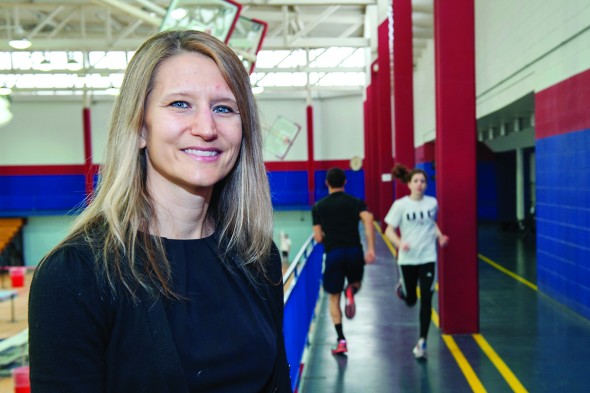Keeping runners’ health on track

Karrie Hamstra-Wright works with the cross-country team to prevent and treat injuries. “I love being a part of research that can not only help our running community at large but our own UIC community,” says Hamstra-Wright, associate professor of kinesiology and nutrition. Photo: Roberta Dupuis-Devlin/UIC Photo Services
Karrie Hamstra-Wright helps keep the cross-country team up and running.
An associate professor of kinesiology and nutrition — and herself a marathon runner — she does research aimed at preventing and treating injuries to runners.
“I really enjoy working with the cross-country team,” said Hamstra-Wright, a faculty member in the College of Applied Health Sciences.
“I love being a part of research that can not only help our running community at large but our own UIC community, our student-athletes.”
Hamstra-Wright does “running gait analysis” with a 3-D camera system that tracks high-speed motion — someone running on a treadmill — with the purpose of developing injury prevention and treatment.
Each study begins before school starts, then tracks runners for injuries through the season.
“We’ll do this for several years, ending up with a database of injured and non-injured athletes, and see if there’s anything in their form that predisposes them to injuries,” she said.
One of the more common variables is for a runner to exert too much inward motion, turning the knees in.
Hamstra-Wright pays attention to stride rates and how runners hit the ground with heel or toe.
“We’re also looking at the shoes they wear,” she said.
“There’s a lot of hypotheses. The shoe wear industry went from a big cushion to barefoot or wearing Vibrams — like a glove for your toes. Now the industry is coming back to a neutral shoe. We’re looking for any emerging patterns on shoe wear.”
Some runners are prone to overuse injuries.
“After evaluating the cross-country team’s running form, we track them for injury, then work with the athletic trainers to find the best treatment,” Hamstra-Wright said.
“Overuse typically occurs due to increases or changes in training in a way their body is not ready for.”
Another study examines the effect of six to eight weeks of strength training for an injury that happens because the kneecap moves around too much, grinding on the bone beneath it.
In what she calls “running biomechanics,” Hamstra-Wright looks at how runners move in general.
“Are they able to do a basic squat or a lunge?” she asked. “It’s not just running.
“You can be a really great runner but have stuff you have trouble doing, like a proper squat to pick something off the floor, which can then influence your running.”
Hamstra-Wright has run six marathons since 2003, in Chicago, Boston, Indianapolis, Grand Rapids, Mich., Harrisburg, Pa., and Kenosha, Wis.
Her best time is 2:57.
“I hope to go below that this year,” she said.
Injuries barred her participation last year.
“I did some shorter stuff, getting ready for some marathons this year,” she said.
“I have a passion for the sport,” Hamstra-Wright said. “There’s a certain mentality of runners I love being around. “I love every aspect of marathons. It’s driven where my research and teaching has gone.”
She runs six days a week, 50 to 80 miles a week “depending on where I’m at in my training cycle,” she said, getting up at 4:15 or 4:30 a.m.
“I love the lakefront,” she said.
She also does strength training six days a week.
Hamstra-Wright grew up “all around the Midwest,” mostly in Wisconsin and Illinois, the daughter of a pastor, and spent her high school years in Lansing.
Her bachelor’s degree is from Olivet Nazarene University in Bourbonnais, with a master’s from UIC and a doctorate from Temple University in Philadelphia.
She taught for a year at the University of Northern Iowa in Cedar Falls in 2004, starting three years of post-doc work at UIC in professor Mark Grabiner’s lab, which specializes in falls among older adults.
The following year was a “flex year” in which she split her time between kinesiology and the Jane Addams College of Social Work.
Hamstra-Wright lives in Little Italy with her husband, Brandon Wright, who works in group ticket sales for the Chicago Bulls.
In her office, there’s a Bulls’ schedule on her bulletin board and a Joakim Noah bobble-head doll on her desk.
Her desk raises so she can stand at her computer, which she does for most of the day.
“From a kinesiology perspective, it’s healthier to be on your feet,” she said.
